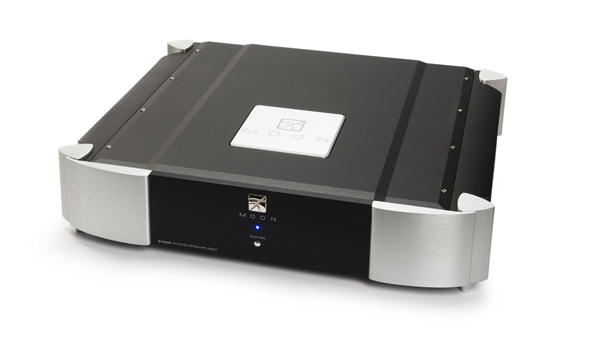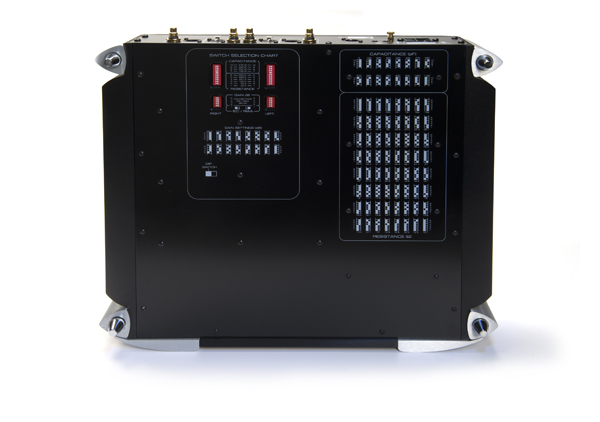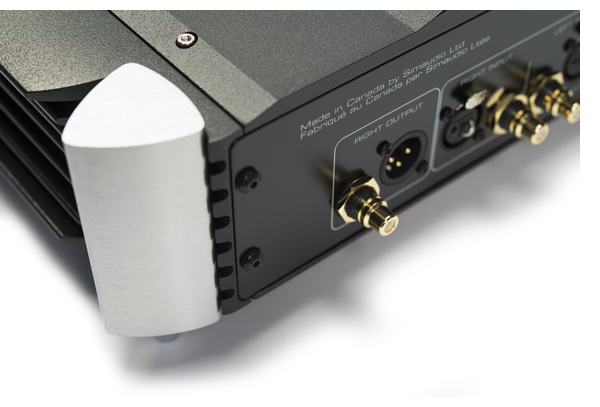Simaudio MOON Evolution 610LP phonostage
 Bouncing between St. Vincent’s current and last album, I can’t help but be in awe of the staying power of the vinyl record. Thanks to the many manufacturers, like Simaudio, who have not only kept the faith, but continue to innovate and refine their designs, spinning records is better than ever in the year 2014 than it ever was. Who knew? Even better much of the technology in flagship designs is making its way down the food chain to more affordable designs like the MOON 610LP here.
Bouncing between St. Vincent’s current and last album, I can’t help but be in awe of the staying power of the vinyl record. Thanks to the many manufacturers, like Simaudio, who have not only kept the faith, but continue to innovate and refine their designs, spinning records is better than ever in the year 2014 than it ever was. Who knew? Even better much of the technology in flagship designs is making its way down the food chain to more affordable designs like the MOON 610LP here.
We’ve been using the Simaudio MOON 810LP phonostage as a reference component for some time now, but at $13,000 is out of reach for a certain group of analog enthusiasts. The $7,500 MOON 610LP, though not inexpensive, opens another door. Comparing the 810LP and 610LP side by side reveals subtle yet profound differences and while the 810LP ultimately reveals more music than the 610LP; some may actually prefer the presentation of the 610LP.
A unified voice
First and foremost the 610LP has a similar, yet slightly softer voicing than the 810LP. The more expensive MOON offers up more resolution on leading and trailing transients in a take no prisoners system, but some of your preference may come down to overall system tuning and associated components. Going back and forth with the Lyra Titan i, I actually preferred the 610LP in my reference system, which is a few clicks to the warm side of neutral. Those wanting every last molecule of resolution will prefer the 810LP, but the 610LP is no slouch. Dare I say it, but the 610LP almost sounds a touch more “tube-like” in the same vein of my favorite solid-state preamps from Pass, Burmester, Robert Koda and Luxman. Never slow or veiled, just a bit lusher than the 810LP, which struck us as one of the most neutral phonstages we’ve had the pleasure to audition.
Tracking through the recent Blue Note remasters and the recent Miles Davis discs from Mobile Fidelity are a perfect example of the 610LP at its finest. This phonostage creates a soundfield that is both extremely deep and wide, going well beyond the boundaries of my Dynaudio Eminence Platinum speakers, but the magic doesn’t stop here. Where the 610LP mirrors the performance of it’s more expensive sibling is in it’s ability to render acoustic instruments naturally.
Switching from the Titan i to the more tonally neutral Atlas, it’s tough to tell these two phonostages apart through the critical midrange, especially with modest dynamic swings. The cymbals at the beginning of Bachman Turner Overdrive’s “Blue Collar” float in the air in front of my listening chair, feeling right spatially as well as feeling as if the drum kit is of a realistic size. The 610LP does not exaggerate perspective, which can be fun for a short period of time wears on you after long listening sessions.
Quiet, quiet, quiet
Though the 610LP has a claimed signal to noise ratio of 93db, while the spec on the 810LP is 95db, you’d be tough to tell them apart. This phonostage is dead quiet. Even the most delicate pieces of classical music, the noise floor is always in the recording, with tape hiss from the master coming through, not the electronics. Personally, this is one of the true benefits of a great solid-state phonostage – the absence of noise. While a number of tubed units can add a touch of palpability (wanted or unwanted) that the solid state units can’t match, they always seem to impart a bit of sporadic tube noise.
Depending on your system, this can go from barely audible to somewhat annoying. Even more annoying is trying to rustle up a matching set of tubes for your phonostage that you love, only to find the tonality changed when it’s time to re-tube. Another awesome reason to go solid-state; turn the 610LP on, leave it on and forget about it forever, unless you change cartridges and need to adjust gain and loading. Personally, as much fun as tube rolling is, I enjoy the consistency of transistors – your mileage may vary.
If you haven’t sampled a top solid-state amplification component in a while, you will be surprised at how lifelike and natural the 610LP renders music without needing vacuum tubes. The gap has been closing for years and Simaudio is one of the rare few that produces solid-state electronics that have no “sound” of their own. If you desire the tonal flavor that comes with a vintage vacuum tube sound, that’s another story.

Mega adjustable
With 64 steps for resistive loading from 12.1 ohms to 47k, 16 steps for capacitive loading from 0pf to 470pf and 16 steps of gain adjustment from 40db to 70db, I can’t imagine a cartridge that the 610LP can’t handle. I certainly had no issues with the cartridges at my disposal and appreciated the wide range of adjustability down at the lower end of the scale – critical with some of the Koetsus and especially the Rega Apheta, which mates incredibly well with the 610LP. Ultra OCD analog lovers will appreciate the fine adjustments available, and again, the more resolving your system, the easier it will be to hear those fine adjustments.
As with the 810LP, all of the adjustments are via DIP switches on the underside of the unit, so this is not a phonostage for casual adjustment. After living with both of these units for some time, I suggest putting your 610LP on a shelf with plenty of height, so you can prop it up and not have to disconnect it or remove it from the rack when making loading settings.
It’s worth mentioning that the 610LP makes an incredible moving magnet phonostage. Though I’m guessing that most analog enthusiasts at this level will have probably graduated beyond the top MM carts (all in the $800 – $1,200 range), if you start your assault on top notch analog, you can start with the 610LP as an anchor and go up the scale on cartridges as your budget allows. The 47k setting is a wonderful match for the Grado moving iron cartridges, which have a low output of .6mv, yet still require 47k loading. For those in the audience with the Grado Statement and Statement 1, the 610LP is a perfect match for these cartridges.
The 610LP also offers balanced inputs as well as outputs. If you have a balanced tonearm cable for your turntable, take advantage of the fully balanced, differential circuit design of the 610LP. Using identical Cardas clear tonearm cables, my impromptu listening panel always picked the balanced option as more open and dynamic. We’re not talking a major delta here, but noticeable enough that even untrained listeners could pick it out, and again, the more resolving your system, the bigger difference it will make, especially if you have a fully balanced system.
Rounding out the package
For those not familiar with Simaudio, all engineering, design and assembly is done at their factory in Montreal, and like Boulder, they do all their chassis metalwork in house as well. The MOON 610LP is a member of their Evolution series, robustly built-both mechanically and electronically, as you would expect from a flagship component.
Lifting the lid reveals a massive power supply that Simaudio claims has more reserve power, is faster and quieter than an equivalent battery supply. Going topless also reveals first-rate components throughout, and having been to the Sim factory (see issue 32) the care taken in machining chassis parts and physical assembly is some of the best our industry has to offer. This is why Simaudio offers a ten year warranty on their products – very few of them ever go back home to the mother ship.

More power
You’ll notice a socket on the rear panel of the 610LP marked “power supply,” allowing you the option to take advantage of Simaudio’s 820S external power supply. We have a review of the 820S in the works and while this massive power supply does extend the range of the 610LP in a mega system, most of you either don’t need it or would be better off stepping up to the 810.
However, because the ($8,000) 820S has outputs marked “analog power” and “digital power,” Those having either the 740P preamplifier, the 650D or 750D DAC/Transport would be well served to split the duty of the 820S between phonostage and one of these other components.
Simaudio’s MOON Evolution 610LP phonostage is a fantastic addition to an analog system, offering an incredibly high price to performance ratio for the analog enthusiast that wants a cost no object phonostage in a single turntable system without refinancing their home.
For all but the most obsessed, this will be the last phonostage you need to buy. Very enthusiastically recommended. -Jeff Dorgay
Simaudio MOON Evolution 610LP phonostage
MSRP: $7,500
PERIPHERALS
| Preamplifier | Robert Koda K-10 ARC REF5SE Burmester 011 |
| Turntable | AVID Acutus Reference SP/Tri-Planar/Lyra Atlas Rega RP10/Apheta |
| Cartridges | Lyra Titan i Lyra Kleos Ortofon Cadenza Bronze Ortofon SPU Ortofon 2M Black Grado Statement 1 Dynavector XV-1S |
| Power Amplifier | Pass Xs300 monoblocks |
| Cable | Cardas Clear |
| Power | IsoTek Super Titan |


